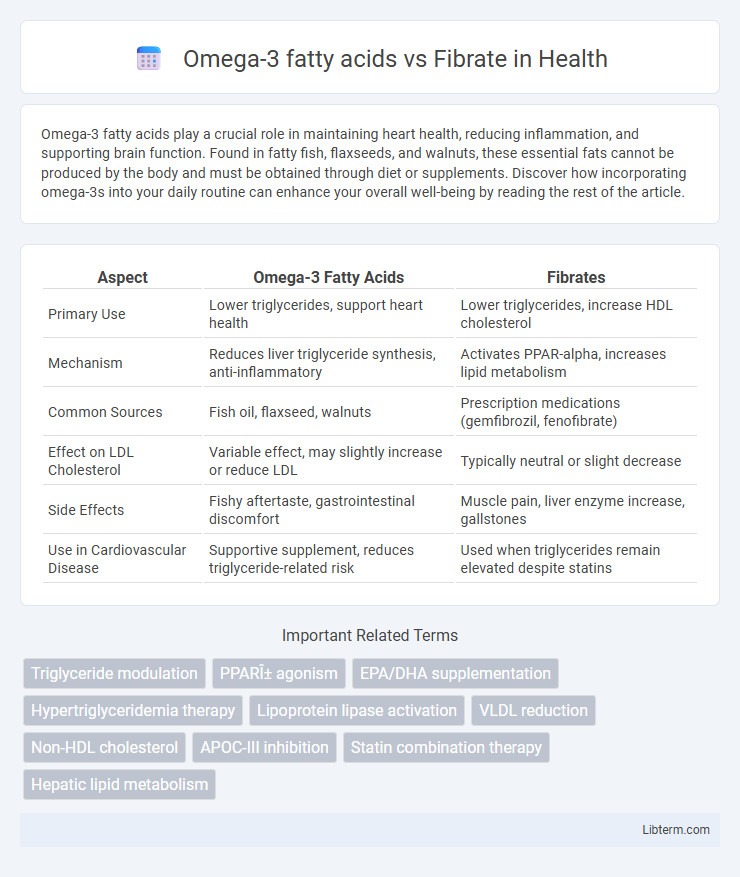Omega-3 fatty acids play a crucial role in maintaining heart health, reducing inflammation, and supporting brain function. Found in fatty fish, flaxseeds, and walnuts, these essential fats cannot be produced by the body and must be obtained through diet or supplements. Discover how incorporating omega-3s into your daily routine can enhance your overall well-being by reading the rest of the article.
Table of Comparison
| Aspect | Omega-3 Fatty Acids | Fibrates |
|---|---|---|
| Primary Use | Lower triglycerides, support heart health | Lower triglycerides, increase HDL cholesterol |
| Mechanism | Reduces liver triglyceride synthesis, anti-inflammatory | Activates PPAR-alpha, increases lipid metabolism |
| Common Sources | Fish oil, flaxseed, walnuts | Prescription medications (gemfibrozil, fenofibrate) |
| Effect on LDL Cholesterol | Variable effect, may slightly increase or reduce LDL | Typically neutral or slight decrease |
| Side Effects | Fishy aftertaste, gastrointestinal discomfort | Muscle pain, liver enzyme increase, gallstones |
| Use in Cardiovascular Disease | Supportive supplement, reduces triglyceride-related risk | Used when triglycerides remain elevated despite statins |
Introduction to Omega-3 Fatty Acids and Fibrates
Omega-3 fatty acids, primarily found in fish oil, play a crucial role in reducing triglyceride levels and promoting cardiovascular health through anti-inflammatory mechanisms. Fibrates, a class of lipid-lowering medications such as gemfibrozil and fenofibrate, primarily target triglyceride reduction by activating peroxisome proliferator-activated receptors (PPARs) to enhance lipid metabolism. Both omega-3 fatty acids and fibrates are effective in managing hypertriglyceridemia but differ in their biochemical mechanisms and additional therapeutic benefits.
Mechanisms of Action: Omega-3 Fatty Acids vs Fibrates
Omega-3 fatty acids primarily reduce triglyceride levels by inhibiting hepatic very low-density lipoprotein (VLDL) synthesis and promoting beta-oxidation of fatty acids, leading to decreased lipid production. Fibrates activate peroxisome proliferator-activated receptor alpha (PPARa), which enhances lipoprotein lipase activity and increases clearance of triglyceride-rich lipoproteins while also raising high-density lipoprotein (HDL) cholesterol. Both agents target lipid metabolism but differ in molecular pathways, with omega-3s modulating fatty acid oxidation and fibrates regulating gene expression related to lipid transport and catabolism.
Effects on Triglyceride Levels
Omega-3 fatty acids effectively reduce triglyceride levels by 20-50% through mechanisms that decrease hepatic triglyceride synthesis and increase clearance. Fibrates lower triglycerides by 30-50% by activating peroxisome proliferator-activated receptor alpha (PPARa), enhancing lipoprotein lipase activity, and promoting fatty acid oxidation. Both agents offer complementary lipid-lowering effects, with omega-3s also improving anti-inflammatory profiles and fibrates primarily targeting triglyceride-rich lipoprotein metabolism.
Impact on HDL and LDL Cholesterol
Omega-3 fatty acids primarily lower triglycerides and have a modest effect on increasing HDL cholesterol while slightly reducing LDL cholesterol. Fibrates are more effective in significantly raising HDL cholesterol and lowering triglycerides but have a variable effect on LDL cholesterol, sometimes causing a slight increase or decrease depending on the individual. Clinical studies suggest fibrates provide a stronger impact on HDL elevation, whereas omega-3 fatty acids offer balanced lipid profile improvements with a focus on triglyceride reduction.
Cardiovascular Benefits: Clinical Evidence
Omega-3 fatty acids have been shown to significantly reduce triglyceride levels, improve endothelial function, and decrease inflammation, ultimately lowering the risk of cardiovascular events such as myocardial infarction and stroke. Fibrates primarily target hypertriglyceridemia and increase HDL cholesterol, with clinical trials indicating reduced incidence of coronary heart disease in patients with atherogenic dyslipidemia. Comparative studies suggest omega-3 fatty acids may provide broader cardioprotective effects when combined with fibrates, optimizing lipid profiles and reducing residual cardiovascular risk in high-risk populations.
Safety Profile and Side Effects Comparison
Omega-3 fatty acids generally exhibit a favorable safety profile with mild side effects such as gastrointestinal discomfort and fishy aftertaste, making them suitable for long-term use in managing hypertriglyceridemia. Fibrates, including drugs like gemfibrozil and fenofibrate, carry a higher risk of adverse effects like muscle toxicity, hepatotoxicity, and potential interactions with anticoagulants, necessitating liver function monitoring during therapy. Clinical data emphasize omega-3 fatty acids as safer alternatives, particularly for patients with pre-existing liver or muscle disorders, while fibrates require careful risk-benefit assessment.
Drug Interactions and Contraindications
Omega-3 fatty acids can interact with anticoagulants and antiplatelet drugs, increasing the risk of bleeding, while fibrates may potentiate the effects of statins, raising the risk of myopathy and rhabdomyolysis. Contraindications for omega-3 supplements primarily include fish or shellfish allergies, whereas fibrates are contraindicated in severe hepatic or renal impairment and gallbladder disease. Careful monitoring is essential when combining these agents with other lipid-lowering drugs or anticoagulants to prevent adverse interactions.
Use in Special Populations (Diabetes, Kidney Disease, etc.)
Omega-3 fatty acids are preferred in patients with diabetes due to their triglyceride-lowering effect without adversely affecting glycemic control, whereas fibrates require caution as they may impact glucose metabolism and increase the risk of muscle toxicity in those with kidney disease. In chronic kidney disease (CKD), omega-3s are generally safer and may provide anti-inflammatory benefits, while fibrates necessitate dose adjustments or avoidance in advanced CKD to prevent accumulation and toxicity. Both agents should be carefully monitored in elderly patients and those with multiple comorbidities to optimize lipid management while minimizing adverse effects.
Omega-3 Fatty Acids vs Fibrates: Cost and Accessibility
Omega-3 fatty acids are widely accessible as over-the-counter supplements and typically cost less than fibrates, which often require a prescription and higher expenditure. Fibrates, such as fenofibrate and gemfibrozil, may involve insurance co-pays or higher out-of-pocket expenses compared to generic omega-3 supplements derived from fish oil or algae. Accessibility to omega-3 fatty acids is enhanced by their availability in various foods and supplements, making them a cost-effective option for managing lipid levels.
Choosing the Optimal Therapy: Clinical Recommendations
Omega-3 fatty acids effectively lower triglycerides and are recommended for patients with mild to moderate hypertriglyceridemia due to their favorable safety profile and cardiovascular benefits. Fibrates offer potent triglyceride reduction and improve HDL cholesterol but carry a higher risk of adverse effects, particularly when combined with statins. Clinical guidelines suggest selecting omega-3 fatty acids for primary hypertriglyceridemia management, reserving fibrates for severe cases or when omega-3 therapy is insufficient or contraindicated.
Omega-3 fatty acids Infographic

 libterm.com
libterm.com